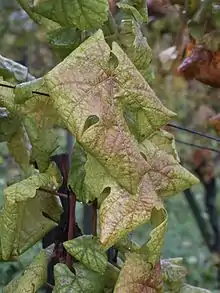Flavescence dorée
Flavescence dorée (from French "Flavescence" : yellowing and "dorée" : golden) is a phytoplasma disease of the vine with the potential to threaten vineyards. The bacterial agent has recently been named Candidatus Phytoplasma vitis, and its vector is the leafhopper, Scaphoideus titanus. Infection may kill young vines and greatly reduce the productivity of old vines.[1] It is classified as a phytoplasma disease belonging to the group generically termed grapevine yellows.[2] Occurrences are in sporadic epidemics, and varieties vary in their sensitivity to it.
| Flavescence dorée | |
|---|---|
 Symptoms on leaves | |
| Common names | flavescence dorée of grapevine |
| Causal agents | Candidatus Phytoplasma vitis |
| Hosts | Vine |
| Vectors | Scaphoideus titanus |
| EPPO Code | PHYP64 |
| Distribution | Europe (France, Switzerland, Germany, Italy), United States, Australia |
| Treatment | uprooting of infected plants |
There is no cure at the moment and the way to manage its spread is by uprooting infected plants and by using selective insecticides in an area-wide pest management approach in order to reduce the hemipteran vectors.
Symptoms
Leaves become red or yellow depending on variety. Twigs stay soft. There is no cold hardening.
Tests
The Phytoplasma bacterium species responsible for the disease cannot be cultured in vitro in cell-free media. Quantitative PCR can be used for the early detection of the bacterium in the plant.
Biology
Ca. Phytoplasma vitis is part of the 16SrV group (group name: Elm yellows) in the Phytoplasma taxonomy.
History
Flavescence dorée first appeared in 1949 in the Armagnac region of south west France.[2] Its insect vector, S. titanus, was originally native to the Eastern United States and Canada and is believed to have been introduced to Europe either during World War II or earlier with American rootstock brought in to fight off phylloxera. Spreading steadily throughout France, it had by 1987 reached the wine growing regions of Cognac, Languedoc and northern and southern Rhône, and by 1992 the Loire Valley, and Bordeaux.[1] Variants of the disease are found in Switzerland, Germany, Italy, New York state, and Australia.
 Symptoms on German variety Scheurebe
Symptoms on German variety Scheurebe Symptoms on German variety Scheurebe
Symptoms on German variety Scheurebe Symptoms on German variety Scheurebe
Symptoms on German variety Scheurebe
See also
- List of grape diseases
- black wood of grapevine or "Stolbur" or "Bois noir", another vine disease due to a Phytoplasma species
References
- winepros.com.au. Oxford Companion to Wine. "grapevine yellows". Archived from the original on 2008-08-08. Retrieved 2008-04-24.
- winepros.com.au. Oxford Companion to Wine. "flavescence dorée". Archived from the original on 2008-08-09. Retrieved 2008-04-24.